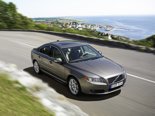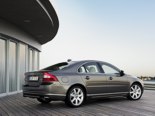

Photographs can be seen in our Volvo Gallery
All new Volvo S80. Advanced driving systems contribute to increased safety margins
27 February 2006
• A new generation of driving and
support systems helps the driver to make the right decision
• BLIS and IDIS make it easier to control the driving situation
• Active Bi-Xenon Light follows the bends in the road
• New advanced functions help shorten the braking distance
• Personal Car Communicator – unique, pocket-sized security control
The all new Volvo S80 is being launched with a new generation of advanced driving and support systems that interact intelligently, contributing to safer driving and greater comfort. Swivelling headlights improve the range of vision when driving in the dark. The S80 owner can now also at a distance detect possible intruders in the car.
The best way to protect the car occupants is to avoid accidents. This was one of the most important starting points when Volvo Cars set about producing the new S80 model. To achieve the company’s uncompromising safety objectives an entirely new generation of advanced driving and support systems was developed, some of which have been presented previously as prototypes.
"The basic principle for our preventive safety systems is that they should not take over the driving or the driver’s responsibility," says Silvia Güllsdorf, S80 Project Director at Volvo Cars. "The aim is to help the driver to make the correct decision in difficult situations by issuing a warning and in different ways indicate how to deal with the situation."
Adaptive Cruise Control
To help the driver to maintain the distance to the car in front, Volvo Cars has
developed the Adaptive Cruise Control, ACC. It should be seen in the first
instance as a comfort function but at the same time it contributes to more
controlled driving when the traffic flow is uneven. This technology also forms
the basis for several of the new safety systems.
The Adaptive Cruise Control uses a radar sensor to measure continuously the distance to the vehicles in front and automatically adapts the speed of the car to help ensure the distance is not too short.
The driver activates the cruise control, setting the desired maximum speed at between 30 and 200 km/h and chooses the minimum time interval to the cars in front. There are five different time intervals to choose from.
"As the Adaptive Cruise Control handles part of the routine driving operations the driver can focus further ahead," says Silvia Güllsdorf. "A driver that has greater foresight often drives with greater safety margins."
Collison Warning with Brake Support
Rear-end collisions are a common type of accident. In many of these accidents
the reason is that the driver was distracted and failed to react in time.
In the light of this, Volvo Cars has developed Collision Warning with Brake Support, CW. This is an advanced system with support functions that help to avoid rear-end collisions or minimise the effect of such a collision.
The area in front of the car is continuously monitored with the aid of a radar sensor. The system is activated in different ways at different phases throughout the whole course of events.
If the car approaches another moving car from behind and the driver does not react, a red warning light flashes on the windscreen. At the same time, an audible signal can be heard. In certain situations this is sufficient for the driver to react and avoid the hazard.
If the risk of a collision increases, despite the warning, the brake support is activated. To shorten the reaction time the brakes are prepared by the brake pads being placed against the discs. The brake pressure is also reinforced hydraulically, ensuring effective braking even if the driver does not press the brake pedal particularly hard.
"If the speed is not too high the brake support will help reduce the effect of a collision," says Silvia Güllsdorf. "But it is always the driver’s reactions that are crucial to the outcome."
If a driver brakes hard the brake lights begin to flash to warn the drivers behind. When the speed is reduced to less than 30 km/h the hazard warning lights are also activated.
To adapt the warning system to different conditions and individual driving styles the sensitivity can be regulated in the setting menu in the car. There are three alternative sensitivity positions.
Advanced information systems contribute to
better driver control
The all new Volvo S80 is also equipped with BLIS (Blind Spot Information System)
and IDIS (Intelligent Driver Information System), two systems that will help the
driver to maintain better control over the driving situation.
With the aid of cameras beside the door mirrors, BLIS registers if another vehicle is in the blind spot alongside the car. In such a situation a warning light beside the mirror is activated to alert the driver and improve the scope to make the correct decision.
IDIS is an electronic information system that contributes to the driver not being distracted by unnecessary information in stressful situations. By continuously checking certain functions in the car, such as wheel movements, movement of the accelerator pedal, indicator control and braking, IDIS can assess the complexity of the situation. The information is processed and at a certain level any information that is not crucial to safety, such as an incoming telephone call or a text message, is delayed.
Active Bi-Xenon Light – swivelling
headlights
To produce an optimal range of vision when driving in the dark on
winding roads, Volvo Cars has launched the Active Bi-Xenon Light – swivelling
headlights that follow the bends in the road. A mini-processor is used to
measure and analyse a number of parameters and optimise the light to suit the
situation. The headlights can be swivelled by up to 15 degrees in each
direction, totalling 30 degrees, and thus have the capacity to illuminate a
longer distance when the road is winding. To save wear on the system, this
function is disconnected automatically in daylight.
To help reduce the risk of blinding oncoming road users the angle of the headlights is adjusted depending on how heavily the car is loaded or if it is accelerating or braking.
The headlights are cleaned by means of an electro-mechanical, high-pressure system that washes one headlight at a time, always offering the best possible light.
Brakes with new, advanced brake functions
The all new Volvo S80 has a highly advanced braking system with
several new functions that interact to ensure the shortest possible braking
distance in all situations.
HYDRAULIC BRAKE ASSIST (HBA) is a new generation of Volvo’s panic brake assistant. It helps the driver to brake in the shortest possible distance in an emergency. As opposed to earlier systems, which are based purely on vacuum, the braking pressure is also reinforced hydraulically. In an emergency situation where the driver does not press the brake pedal sufficiently hard, HBA helps to ensure the ABS system is used optimally and the braking distance shortened.
OPTIMISED HYDRAULIC BRAKES (OHB) reinforces the braking capacity in conjunction with hard braking by using hydraulics to compensate for low vacuum pressure in the brake servo.
READY ALERT BRAKES (RAB) can predict rapid braking and place the brake pads against the brake discs even before the driver presses the brake pedal. In doing so, the braking system’s reaction time – and braking distance – is shortened. The signal to the braking system could be that the accelerator pedal is released quickly or that the Adaptive Cruise Control registers an obstacle in front of the car.
FADING BRAKE SUPPORT (FBS) uses hydraulics to gradually build up the braking pressure in conjunction with persistently hard braking to help reduce the risk of wear and retained pedal feeling.
Personal Car Communicator – world first
with a heartbeat sensor
In an increasingly insecure world it is important to have control over what is
happening around you, particularly when travelling by car.
"Personal security is one of the cornerstones of the Volvo safety profile," says Silvia Güllsdorf. "It is about having your car left undisturbed and avoiding situations that could entail personal risk."
Together with the all new Volvo S80, the Personal Car Communicator (PCC), an advanced, pocket-sized control function, is also being launched. It provides information which in certain situations could be crucial to the security of the car owner.
The Personal Car Communicator is surprisingly like a normal remote
control but can do a great deal more than activate locks and alarms. By simply
pressing a button the car owner can within a few seconds acquire information
about.
. whether the car is locked or unlocked.
. whether the alarm is activated or not.
. whether the alarm is activated and if there is someone in the car, which is
registered using a highly sensitive heartbeat sensor and an advanced calculation
process.
The information is accessible and relevant as long as the distance between the PCC and the car is within approximately 100 metres. However, the most recent information is stored so that at any time and in any place a check can be made to see if the car was actually locked when it was parked.
Click to enlarge
Legal | Privacy | Contact Us | Search | Site Map
Volvo Owners' Club Limited® 1962-2025




